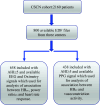All Obstructive Sleep Apnea Events Are Not Created Equal: The Relationship between Event-related Hypoxemia and Physiologic Response
- PMID: 38252424
- PMCID: PMC11109914
- DOI: 10.1513/AnnalsATS.202309-777OC
All Obstructive Sleep Apnea Events Are Not Created Equal: The Relationship between Event-related Hypoxemia and Physiologic Response
Abstract
Rationale: Obstructive sleep apnea (OSA) severity is typically assessed by the apnea-hypopnea index (AHI), a frequency-based metric that allocates equal weight to all respiratory events. However, more severe events may have a greater physiologic impact. Objectives: The purpose of this study was to determine whether the degree of event-related hypoxemia would be associated with the postevent physiologic response. Methods: Patients with OSA (AHI, ⩾5/h) from the multicenter Canadian Sleep and Circadian Network cohort were studied. Using mixed-effect linear regression, we examined associations between event-related hypoxic burden (HBev) assessed by the area under the event-related oxygen saturation recording with heart rate changes (ΔHRev), vasoconstriction (vasoconstriction burden [VCBev] assessed with photoplethysmography), and electroencephalographic responses (power ratio before and after events). Results: Polysomnographic recordings from 658 patients (median [interquartile range] age, 55.00 [45.00, 64.00] yr; AHI, 27.15 [14.90, 64.05] events/h; 42% female) were included in the analyses. HBev was associated with an increase in all physiologic responses after controlling for age, sex, body mass index, sleep stage, total sleep time, and study centers; for example, 1 standard deviation increase in HBev was associated with 0.21 [95% confidence interval, 0.2, 0.22], 0.08 [0.08, 0.09], and 0.22 [0.21, 0.23] standard deviation increases in ΔHRev, VCBev, and β-power ratio, respectively. Conclusions: Increased event-related hypoxic burden was associated with greater responses across a broad range of physiologic signals. Future metrics that incorporate information about the variability of these physiologic responses may have promise in providing a more nuanced assessment of OSA severity.
Keywords: apnea–hypopnea index; electroencephalogram; heart rate response; hypoxic burden; obstructive sleep apnea.
Figures




References
Publication types
MeSH terms
Grants and funding
LinkOut - more resources
Full Text Sources

